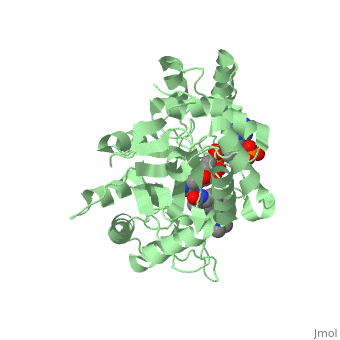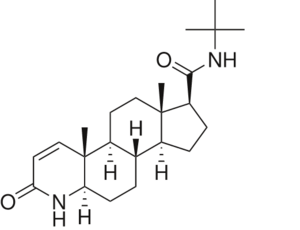Sandbox 45673
From Proteopedia
(Difference between revisions)
| Line 30: | Line 30: | ||
[[Aromatase]] and 5α-reductase is responsible for converting androgen hormones into estrogen and dihydrotestosterone (DHT). This chemical process of androgen hormones leads to a decrease in testosterone, but raises levels of DHT and estrogen. Estrogen is a key role in cells proliferating in the prostate and DHT is an anabolic hormone much more potent (dissociated from the androgen receptor slowly) than testosterone that when combined, causes a synergy to induce BPH. The enzyme 5α-reductase is responsible for the synthesis of DHT in the prostate from circulating testosterone. 5α-reductase is located in the stromal cells, which is the main site for the synthesis of DHT, but it can also diffuse into epithelial cells close-by. In both stromal and epithelial cells, DHT binds to nuclear androgen receptors and signals for transcription for cell growth. Finasteride is used to inhibit the 5α-reductase enzyme, which blocks the conversion of testosterone and inhibits the production of DHT, reducing prostate volume and BPH symptoms (urinating complication). Using finasteride could increase the risk for erectile dysfunction, decrease libido, and ejaulation disorder due to 5α-reductase being inhibited. | [[Aromatase]] and 5α-reductase is responsible for converting androgen hormones into estrogen and dihydrotestosterone (DHT). This chemical process of androgen hormones leads to a decrease in testosterone, but raises levels of DHT and estrogen. Estrogen is a key role in cells proliferating in the prostate and DHT is an anabolic hormone much more potent (dissociated from the androgen receptor slowly) than testosterone that when combined, causes a synergy to induce BPH. The enzyme 5α-reductase is responsible for the synthesis of DHT in the prostate from circulating testosterone. 5α-reductase is located in the stromal cells, which is the main site for the synthesis of DHT, but it can also diffuse into epithelial cells close-by. In both stromal and epithelial cells, DHT binds to nuclear androgen receptors and signals for transcription for cell growth. Finasteride is used to inhibit the 5α-reductase enzyme, which blocks the conversion of testosterone and inhibits the production of DHT, reducing prostate volume and BPH symptoms (urinating complication). Using finasteride could increase the risk for erectile dysfunction, decrease libido, and ejaulation disorder due to 5α-reductase being inhibited. | ||
| + | |||
| + | '''Prostate Cancer''' | ||
| + | |||
| + | Prostate cancer is an androgen dependant adenocarcinoma. The FDA has not approved finasteride as a treatment for prostate cancer. A warning was added, 5α-reductase inhibitors concerning an increased risk of high-grade prostate cancer, as the treatment of BPH lowers PSA (prostate-specific antigen), which could mask that prostate cancer is present. | ||
'''Androgenetic Alopecia (AGA)''' | '''Androgenetic Alopecia (AGA)''' | ||
| Line 35: | Line 39: | ||
Androgenetic alopecia (AGA) is an androgen-dependent, progressively thinning of the scalp hair. AGA is also referred to as male-pattern hair loss or baldness (MPB) and female-pattern hair loss in women. It is characterized by progressive shortening of the duration of anagen with successive hair cycles, leading to decreased numbers of hair in anagen at any given time, and aggressive follicular miniaturization with conversion of terminal to vellus-like follicles. The reason for the use of finasteride to treat AGA in men is based on the absence of AGA in men with congenital deficiency of type 2 5α-reductase, and the presence of increased 5α-reductase activity and DHT levels in balding scalp. This condition is caused by a build up of DHT in tissues, which in the case of MPB, is the scalp. The build up of DHT causes androgen-dependent miniaturization of scalp hair follicles. Testosterone is the primary androgen in the body, but to be maximally active in scalp hair follicles it must be converted to dihydrotestosterone (DHT) by the enzyme 5α-reductase. Inhibition of the enzyme with Finasteride has been shown to reduce both serum and scalp skin DHT levels in balding men. In some patients, hair regrowth can occur.<ref name="twenty one"> Olsen, E. A., Hordinsky, M., & Whiting, D., et al. (2006, December). </ref> Side effects from Finasteride include but are not limited to, decreased sexual ability and desire. <ref name="twenty two"> Leyden, James et al.(June 1999)."Finasteride in the treatment of men with frontal male pattern hair loss." Journal of the American Academy of Dermatology. Volume 40 , Issue 6 , 930 - 937 </ref> | Androgenetic alopecia (AGA) is an androgen-dependent, progressively thinning of the scalp hair. AGA is also referred to as male-pattern hair loss or baldness (MPB) and female-pattern hair loss in women. It is characterized by progressive shortening of the duration of anagen with successive hair cycles, leading to decreased numbers of hair in anagen at any given time, and aggressive follicular miniaturization with conversion of terminal to vellus-like follicles. The reason for the use of finasteride to treat AGA in men is based on the absence of AGA in men with congenital deficiency of type 2 5α-reductase, and the presence of increased 5α-reductase activity and DHT levels in balding scalp. This condition is caused by a build up of DHT in tissues, which in the case of MPB, is the scalp. The build up of DHT causes androgen-dependent miniaturization of scalp hair follicles. Testosterone is the primary androgen in the body, but to be maximally active in scalp hair follicles it must be converted to dihydrotestosterone (DHT) by the enzyme 5α-reductase. Inhibition of the enzyme with Finasteride has been shown to reduce both serum and scalp skin DHT levels in balding men. In some patients, hair regrowth can occur.<ref name="twenty one"> Olsen, E. A., Hordinsky, M., & Whiting, D., et al. (2006, December). </ref> Side effects from Finasteride include but are not limited to, decreased sexual ability and desire. <ref name="twenty two"> Leyden, James et al.(June 1999)."Finasteride in the treatment of men with frontal male pattern hair loss." Journal of the American Academy of Dermatology. Volume 40 , Issue 6 , 930 - 937 </ref> | ||
| - | '''Prostate Cancer''' | ||
</StructureSection> | </StructureSection> | ||
== References == | == References == | ||
<references/> | <references/> | ||
Revision as of 08:48, 6 December 2016
N-(1,1-dimethylethyl)-3-oxo-(5α,17β)-4-azaandrost-1-ene-17-carboxamide (Finasteride)
| |||||||||||
References
- ↑ 1.0 1.1 I.K. Morton; Judith M. Hall (6 December 2012). Concise Dictionary of Pharmacological Agents: Properties and Synonyms. Springer Science & Business Media. pp. 121, 246. ISBN 978-94-011-4439-1
- ↑ 2.0 2.1 Yamana K, Labrie F, Luu-The V (January 2010). Human type 3 5α-reductase is expressed in peripheral tissues at higher levels than types 1 and 2 and its activity is potently inhibited by finasteride and dutasteride. Hormone Molecular Biology and Clinical Investigation. 2 (3). doi:10.1515/hmbci.2010.035
- ↑ Varothai, S; Bergfeld, WF (Jul 2014). "Androgenetic alopecia: an evidence-based treatment update.". American journal of clinical dermatology. 15 (3): 217–30. doi:10.1007/s40257-014-0077-5. PMID 24848508
- ↑ 4.0 4.1 Lednicer D (2011). Steroid Chemistry at a Glance. Hoboken: Wiley. ISBN 978-0-470-66084-3
- ↑ Burkhard Fugmann; Susanne Lang-Fugmann; Wolfgang Steglich (28 May 2014). RÖMPP Encyclopedia Natural Products, 1st Edition, 2000. Thieme. pp. 1918–. ISBN 978-3-13-179551-9
- ↑ Schieck, Cynthia L.(1998, August) "Finasteride (Propecia ®)". http://www.chm.bris.ac.uk/motm/finasteride/Finasteride%20(Propecia)%20-%20Feature%20Molecule.htm
- ↑ 7.0 7.1 Bull, Herbert G.*Garcia-Calvo,Margarita Andersson,Stefan†, Baginsky, Walter F.,Chan,H. Karen,Ellsworth,‡ Dina E., Miller,§ Randall R., Stearns,Ralph A.,Bakshi,Raman K.,Rasmusson, Gary H.,Tolman,Richard L., Myers,Robert W.,Kozarich,John W.,Harris,Georgianna S. (1995, August 6) Mechanism-Based Inhibition of Human Steroid 5R-Reductase by Finasteride: Enzyme-Catalyzed Formation of NADP-Dihydrofinasteride, a Potent Bisubstrate Analog Inhibitor. http://pubs.acs.org/doi/pdf/10.1021/ja953069t
- ↑ Olsen, E. A., Hordinsky, M., & Whiting, D., et al. (2006, December).
- ↑ Leyden, James et al.(June 1999)."Finasteride in the treatment of men with frontal male pattern hair loss." Journal of the American Academy of Dermatology. Volume 40 , Issue 6 , 930 - 937



